9+ SAMPLE Business Loan Contract
-

Business Loan Entity Contract
download now -
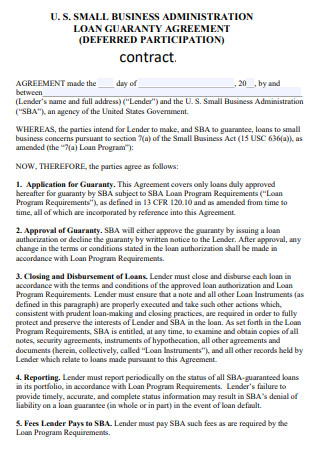
Small Business Loan Contract
download now -
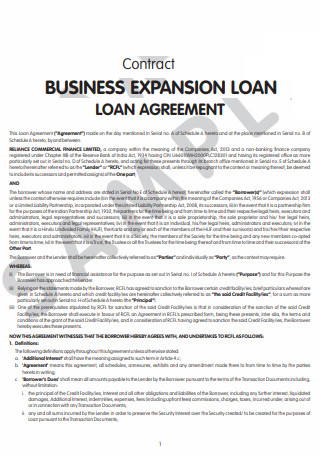
Business Expansion Loan Contract
download now -
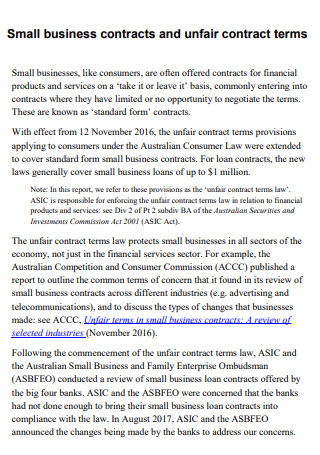
Sample Business Loan Contract
download now -
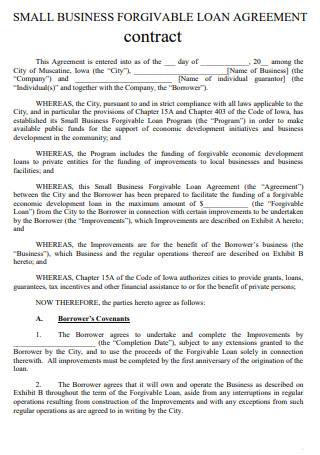
Business Forgivable Loan Contract
download now -
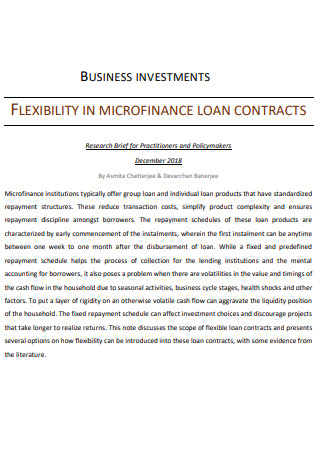
Business Investment Loan Contract
download now -

Business Loan Program Contract
download now -
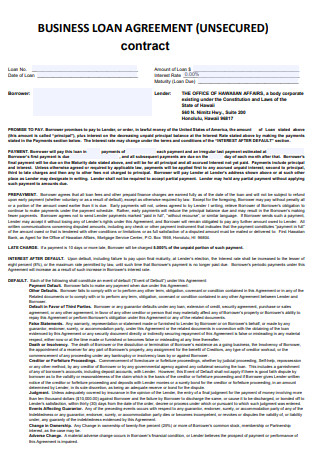
Business Loan Agreement Contract
download now -
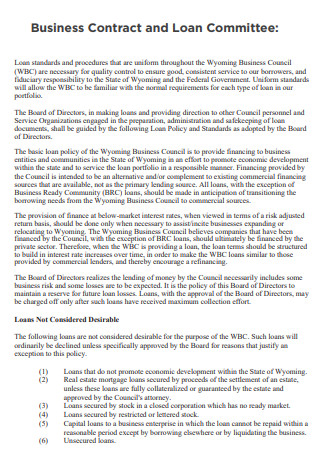
Business Loan Committee Contract
download now -
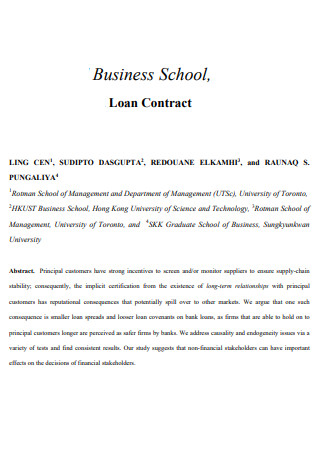
Business School Loan Contract
download now
FREE Business Loan Contract s to Download
9+ SAMPLE Business Loan Contract
What IS a Business Loan Contract?
4 Types of Business Loans
Writing the Business Loan Contract
FAQs
What is a “severability clause” in a contract?
What is a loan agreement?
What are contract covenants?
What will happen if either the lender or the borrower dies before fully repaying the loan?
What IS a Business Loan Contract?
A Business loan contract is a document that records the terms and conditions of the loan agreement between a lender and a borrower, in this case, a business company. A business loan, also known as a commercial loan, is a kind of loan that is used primarily for business purposes. The loan contract contains all the information about the debt and typically serves as a guide on how the payment for the loan will be made and on what terms. More than just a piece of documentation, a business loan contract is a protection for both the borrower and the lender. Whether you’re just an individual borrower or a business owner, or whether you’re a financial lending business owner or just an individual lender, you have rights that are entitled to be met and secured to guarantee that your transaction will be dealt with fairly. In legal terms, infringement is the act of breaking or violating the terms of the agreement in a contract. This is what a business loan contract seeks to protect against.
4 Types of Business Loans
There are lots of reasons why businesses secure loans. It could be for starting a business, for buying the equipment and resources needed to run the business, for business growth expansion, or even to help float a business from going bankrupt. The type of business loan could also depend on the amount of loan needed, the duration of payment, and the financial requirements needed to be approved for a loan. Being aware of the right type of business loan to avail is important. You would not want to just avail of any loans without being knowledgeable about their type, terms, and requirements. These are the top four commonly available business loans offered.
Writing the Business Loan Contract
Identifying the type of business loan to avail for your business is the first step to take. Knowing how to write the actual business loan contract is the next thing you need to do. A business loan contract should be simple, concise, and easy to understand. There should be no room for confusion or misinterpretation. Like all types of contracts, a business loan contract seeks to protect the rights of both the borrower and the lender. Contracts typically follow a format to ensure that all the essential elements of a contract are included. Below are the essential elements of a business loan contract.
-
1. Identifying the Parties Involved
The first section of a business loan contract should contain the name of both the borrower and the lender, or the lending institution, their addresses, and other pertinent contact information. Identifying the parties involved in a business loan contract is crucial to sealing the agreement. As much as possible, make sure that the names listed are spelled correctly, including the addresses. The phone numbers, mobile numbers, and other contact information should be accurately listed as well.
-
2. Date of the Loan Agreement and the Loan Amount
The next essential part of the contract is the date as to when the loan contract was agreed upon and the loan amount that was approved. This section signifies when the borrower agreed and signed off on the loan details, as well as the borrower’s concurrence on the loan amount. This is important since the date usually marks the signal of when the loan was or will be released, and the start of counting for the period of repayment of the loan. Oftentimes, one of the requirements for availing of a loan is that you have collateral upfront. Collateral is any type of asset that is offered up as security for a loan, serving as the lender’s protection in case of a payment default.
-
3. Payment Terms and Conditions & the Interest Rate
This section is important in any kind of loan contract, and perhaps the most important part of the contract, and is something that is taken very seriously. The payment plan terms and conditions section provides the guidelines for the repayment agreement process of the loan. The details of how and when the payment is included, whether it be done in loan amortization or installment, one-time payment, or in any other agreed type of payment duration terms. The how-to makes a payment can include doing online bank payment transfers, over-the-counter cash payments, cheque payments, and so on. The payment terms and conditions also reduce the risk of non-payment. The interest rate of the loan is also noted in the terms and conditions. Overall, the terms and conditions should include the following details: payments due date (should include dates for installment payments as necessary); the type of subscription and payment invoicing; the currency and payment methods to be used; discounts, incentives, and offers for early payments, or cash incentives for referral of potential new customers, as applicable; and/or terms and conditions for payment defaults, or late payments. These details should be written clearly, using plain language, to avoid being misconstrued.
-
4. Default Provisions
The default provision section outlines the actions or remedies the lender could take in case the borrower defaults in payment. Default in payment meant that the borrower failed to make the payment on the agreed date(s) or when demanded by the lender, as long as due notice was also provided. The default provision usually includes what are the penalties involved for overdue payments. Overdue payments usually become immediately due and payable, but the default provision could also provide a grace period with a penalty fee to give the borrower more time to make the payment. This section also sets out the rights of the lender to seek legal remedies such as filing a lawsuit for breach of contract.
-
5. Governing Laws and Signatories
This section provides whatever state laws or local jurisdictions covering the contract upon where the contract was made. These are the laws that are applied when making and interpreting the business loan contract. An example of a governing law statement goes: “This contract shall be governed by the laws of the State of California.” Right after this section comes the signatories part. The signatures signify the binding agreement, both parties, the borrower and the lender, agreed to all the terms, conditions, and/or provisions that are detailed and outlined in the contract. Most financial lending institutions would require a guarantor agreement, or a co-maker. A co-maker is someone who is also held responsible for paying the loan in case the borrower defaults in payments, which makes the co-maker equally liable as well to whatever terms and conditions are stated in the contract. So, as part of the signatories, there should also be a space for co-makers to sign as applicable. And, to completely seal off the contract, a lot of times a notary acknowledgement is also required.
FAQs
What is a “severability clause” in a contract?
Contracts often contain a severability clause. A severability clause is a provision that declares the independence of a certain term in the contract. Meaning, the rest of the contract’s terms and conditions shall remain effective even if other provisions are deemed unenforceable mainly due to their illegal nature. This clause seeks to protect the rights of all parties concerned when the agreement was already made, especially in a business loan contract when the loan was already to the borrower. Hence, if a contract does not contain a severability clause, and a provision within a contract was found to be illegal, the whole contract itself will then be deemed as void and/or unenforceable. Investopedia gives a good example of a severability clause statement that goes “If a provision of this Agreement is or becomes illegal, unenforceable, or invalid in any jurisdiction, it shall not affect (1) the enforceability or validity in that jurisdiction of any other provision of this Agreement, or (2) the enforceability or validity in other jurisdictions of that or any other provision of this Agreement.”
What is a loan agreement?
For any kind of loan, whether it’s a personal loan or a business loan, there should always be an agreement that seals the lending transaction. A loan agreement contains all the details that protect the parties that entered into the loan transaction. It should contain the name and contact information of the parties; the loan amount; the date when the agreement was made, the loan was released, and the repayment date; the payment terms and conditions which include the payment method, applicable interest rate, and so on; other provisions which can cover instances of late payment or loan payment default; signatures, and other essential provisions that are securing the rights and obligations of the parties.
What are contract covenants?
A covenant in a contract is a binding agreement, a promise, by the parties involved to do, to act, or to provide something, and/or the opposite of to not to do, to not to act or to refrain from providing something. Lenders oftentimes would require covenants as part of a business loan contract. Examples of covenants in a loan contract include providing proof of insurance for the security or the collateral that the borrower is pledging; payment of taxes and fees associated with assets held up as security; or that the borrower will not incur any other additional debt in concurrent with the existing debt.
What will happen if either the lender or the borrower dies before fully repaying the loan?
If the lender dies before the loan is paid, the estate of the lender or the lender’s beneficiaries has the right to receive or to collect the payment of the loan from the borrower. Likewise, if the borrower dies before paying off the loan, the authorities will use the borrower’s remaining assets to pay off the loan. Or if there is a co-maker or a co-signer along with the loan, then the co-maker has the responsibility to pay off the existing loan.
Business loans are secured for start-up businesses, businesses looking to grow and expand, or businesses who need additional capital to stay afloat. And even if a business is doing well, sometimes taking out a loan will allow the business to maintain their existing cash flow as a sort of emergency savings to counter whatever unexpected circumstances that might take place, using the loan instead of as the active cash flow for the business expenses. In this case, to seal the deal and make the transaction between the business and the lender legitimate, they need to have a well-drafted business loan contract.
Are you a lender who needs help in drafting and creating that solid business loan contract? Our business loan contract templates are ready-drafted with the right elements that all you have to do is just to fill out what’s being asked, and you’re ready to go! So, download one now!
